On International Workers’ Day, May 1, 1981, the National Federation of Nurses Unions (NFNU) was created as an organization to represent unionized nurses at the national level. More than 300 delegates representing every nurses union in Canada voted unanimously to form the organization, which was renamed to the Canadian Federation of Nurses Unions (CFNU) in 1999.
Explore the timeline below to find out more about the key moments over the years that have shaped the CFNU and provincial nurses unions in Canada. To learn more, read our book, Taking Our Place: Stories from Leaders of Canada’s Nurses Union Movement.
WWII marked a major turning point for Canada, for women, for our health care system and for the nurses who worked in it. The war ended the Great Depression, and nurses wanted better working conditions and more equitable treatment, including pay comparable to other professions. As this movement grew, the Canadian Nurses Association (CNA) approved collective bargaining in principle and recommended that the provincial nurses associations be certified as bargaining agents. This decision may have been influenced by the passage of the federal Wartime Labour Relations Regulation in 1944 (P.C. 1003), which contained a comprehensive framework for recognizing unions.
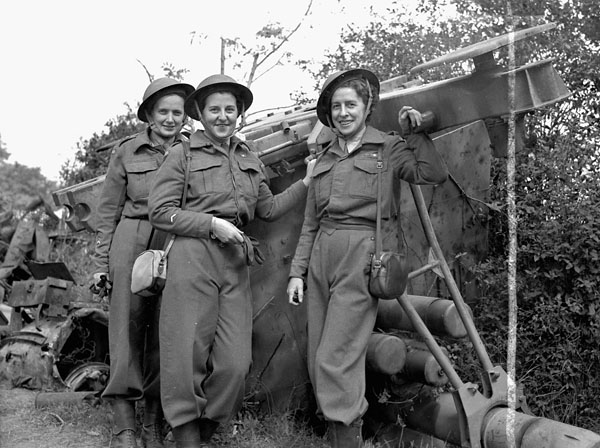
In 1946 the Quebec Nurses’ Act providing for collective bargaining was passed, and Montreal nurses established the first independent nurses union, the Alliance des Infirmières de Montréal (AIM), an affiliate of the Canadian and Catholic Confederation of Labour which became, in 1960, the Confederation of National Trade Unions.
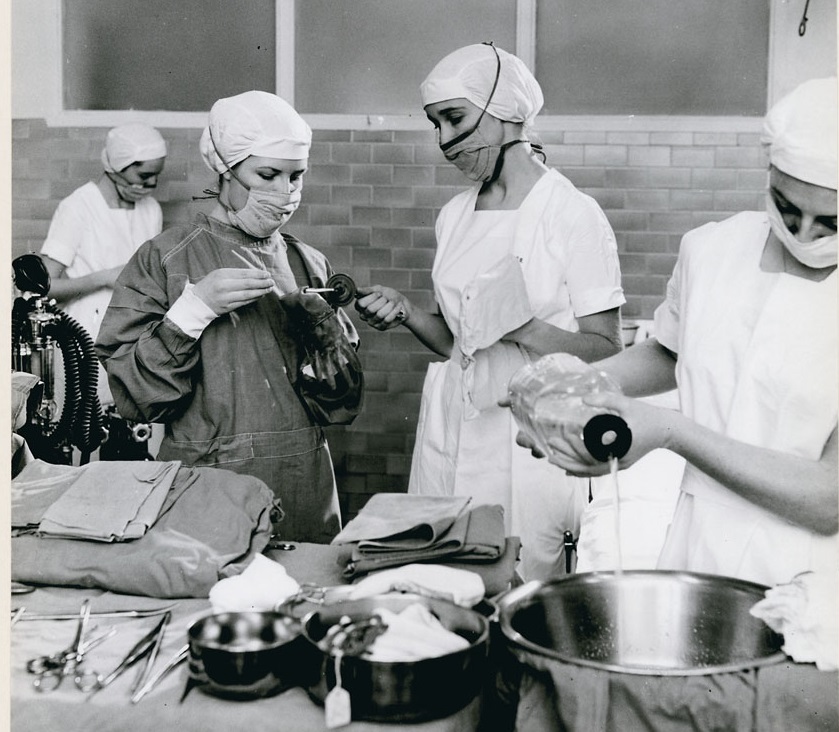
The CNA did not initially fully support unionization. It was dominated by nurses who were in management roles, and whose interests were sometimes at odds with staff nurses who were working on the front lines. In 1946 the CNA passed a resolution at its annual general meeting against “any nurse going on strike at any time for any cause,” a resolution that was not repealed until 1972.
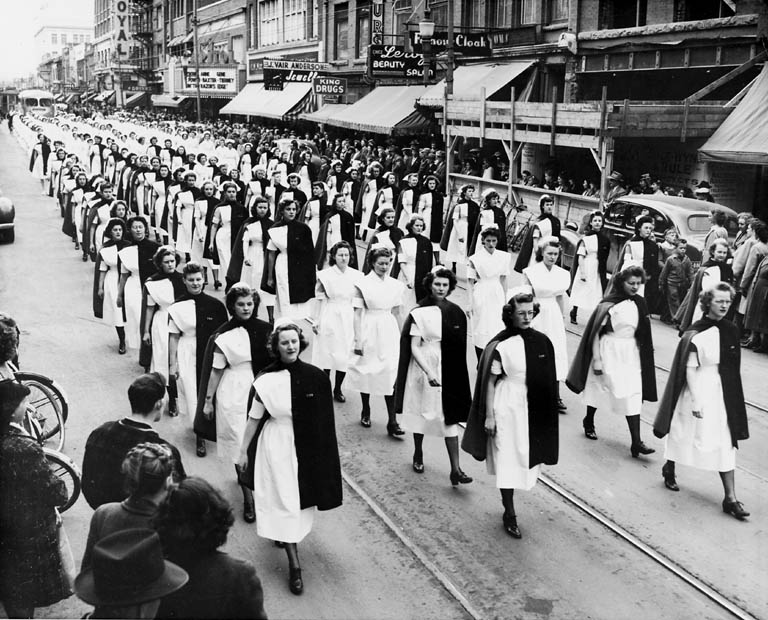
By 1971, the idea of a national organization of nursing students in Canada had been discussed for many years. In this year, the Canadian University Nursing Students’ Association (CUNSA) was founded to represent university nursing students. The intent was to later expand to include diploma students. This idea remained dormant for almost 20 years.
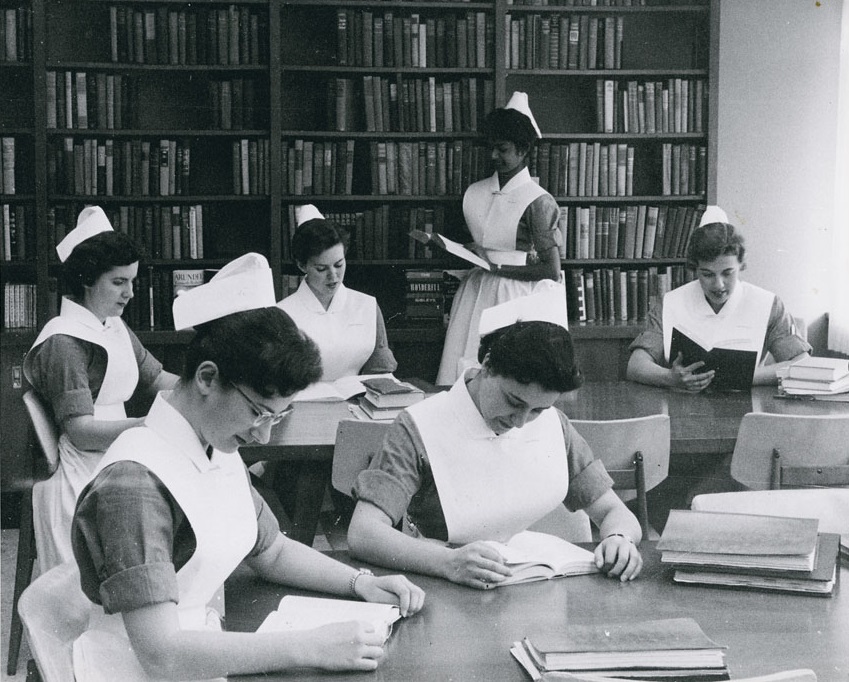
In the early 1970s different nurses associations across Ontario bargained separately as individual units. Nurses wanted standard wages and working conditions and requested that the provincial nurses association form a central union.
The Ontario Nurses’ Association was founded during an all-day meeting at Toronto Westbury Hotel in 1973. The media release announced that “A province-wide union was formed on October 13, 1973, for the purpose of collective bargaining for nurses by nurses. Over 300 representatives of 85 independent nurses associations certified as bargaining agents for nurses employed in institutions providing health care, public health units, visiting nurses organizations and industry nurses adopted a constitution establishing the Ontario Nurses’ Association (ONA).”
The CNA recognized that poor working conditions faced by nurses required action. Many provincial associations began to undertake collective bargaining, some forming separate labour relations or bargaining committees to do so. Nurses’ lack of success in trying to improve working conditions and wages through this arrangement pushed them further toward unionization.
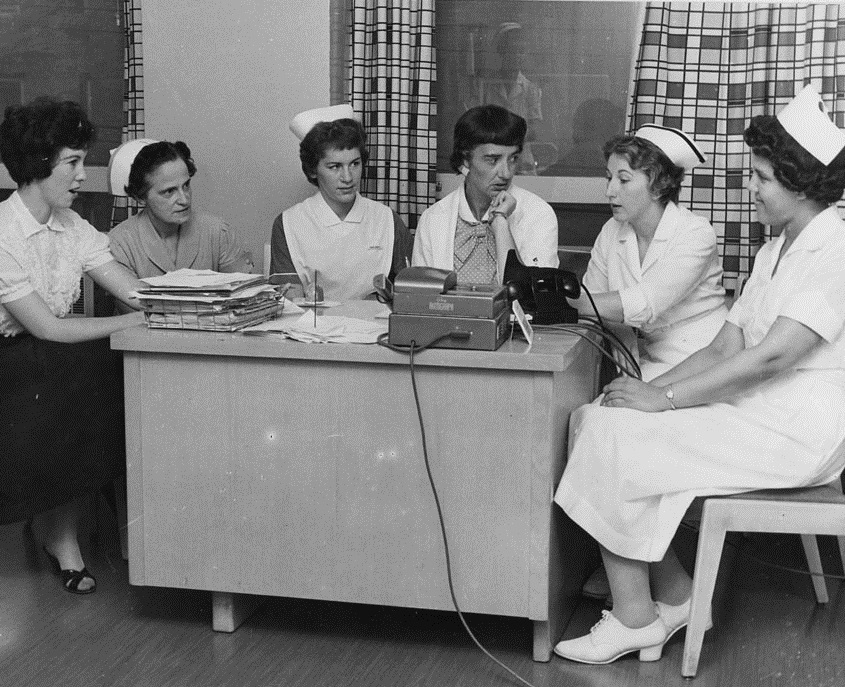
A landmark decision in Canadian labour law promoted the separation of collective bargaining units from provincial nurses’ associations and changed the lives of all Canadian nurses.
In 1973, the Supreme Court of Canada established the ineligibility of the Saskatchewan Association of Registered Nurses to be a bargaining agent for staff nurses. This ruling upheld the original decision of the Saskatchewan Court of Appeal, which found that the nurses association couldn’t act as a bargaining agent because it was management-dominated, and this constituted a conflict of interest.
Nurses in Ontario already had separate bodies, and nurses associations in other provinces had begun to act more like unions by taking various kinds of actions against their employers. Many provincial nurses associations had separate bargaining committees with varying degrees of independence. The Supreme Court decision reinforced a trend that had already begun. After the decision, independent nurses unions were formed across the country.
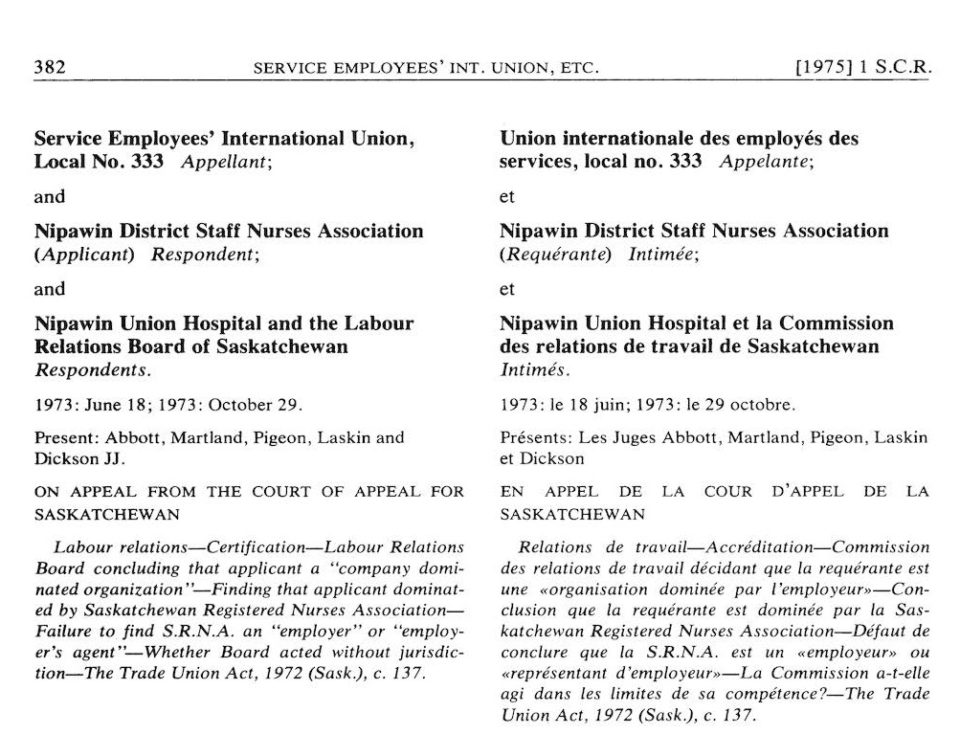
Represented by the Registered Nurses’ Association of Nova Scotia, nurses in Windsor (Nova Scotia) organized. At first, only about half of the nurses joined, but after a long series of meetings, the membership rose to close to 100%. When bargaining stalled, a strike vote was called, with the strike set to begin the day before Queen Elizabeth II was scheduled to open the new Windsor hospital. The employer settled.
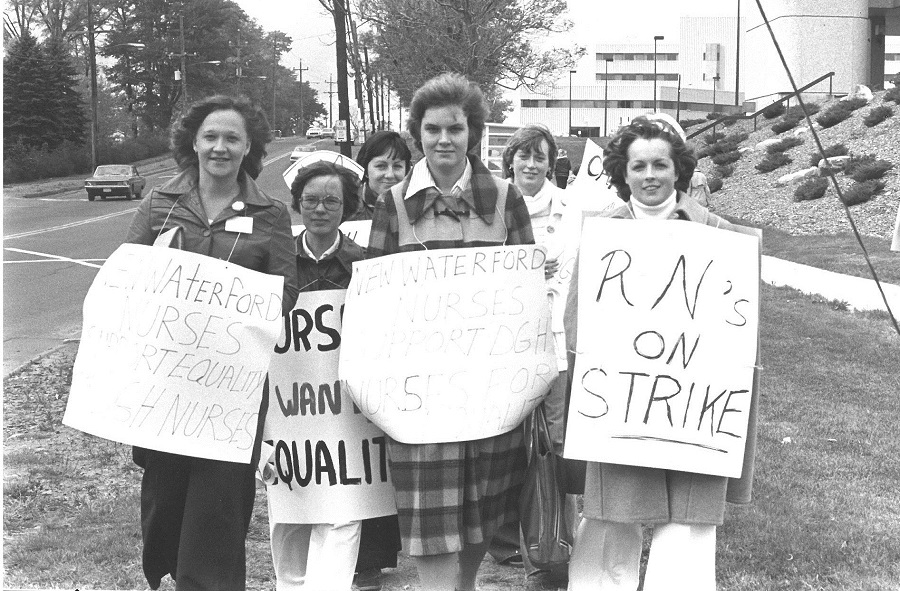
In 1974, an organizing drive began to solicit membership for a nurses union, and the response was overwhelming. The previous year, a new law had passed prohibiting management influence in employee organizations. As the provincial nurses association consisted of both management and staff, nurses were prompted to seek a stronger, unified voice for collective bargaining.
The Newfoundland Nurses Union was formed in the fall of 1974. The name was later changed to the Newfoundland and Labrador Nurses’ Union (NLNU). NLNU remained the official name of the organization until 2014 when the union added the word “registered” to its name to more accurately reflect its membership, making it the Registered Nurses’ Union Newfoundland & Labrador (RNUNL).
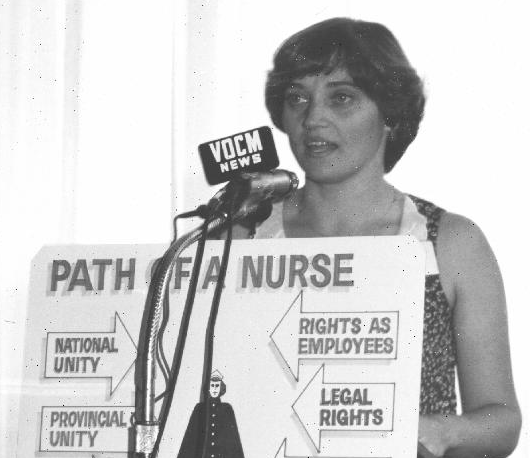
SUN was officially born on January 19, 1974. When the Supreme Court of Canada made its landmark decision that Saskatchewan’s provincial nursing association could not effectively represent the average nurse because it was dominated by those in management positions, SUN’s official formation became inevitable.
Pressed by upcoming negotiations for a new contract, a group of staff nurses associations from Saskatoon took the initiative to form a negotiating committee and a committee to study alternatives for nurses to maintain their autonomy. At a meeting to discuss this study, 89 nurses from 43 staff nurses associations and other nurses groups voted unanimously to approve a motion to form a labour organization to represent nurses in Saskatchewan.
Protesting the rejection of nurses’ requests to address wage issues, nurses from fifteen public hospitals across New Brunswick started to call in sick during 1975. Nurses called it the “blue flu.” Their actions were proclaimed in the press and by NB Premier Hatfield as irresponsible.
An injunction was issued on February 7, 1975, ordering Hôtel-Dieu Campbellton nurses back to work. Even when the salary dispute was settled the following year with a remarkable 24% wage increase, nurses knew that they had a long way to go to protect their rights.
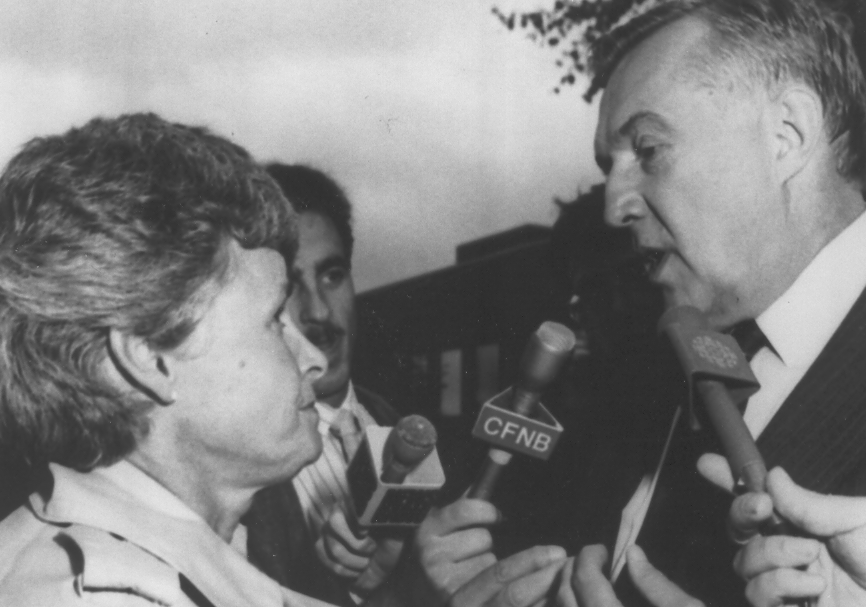
MONA was established in 1975, and that same year, with a strike mandate, it achieved significant wage increases for nurses. Within eight years, membership grew to 7,000 and wages went from $3.87 to $12.48 per hour, plus benefits.
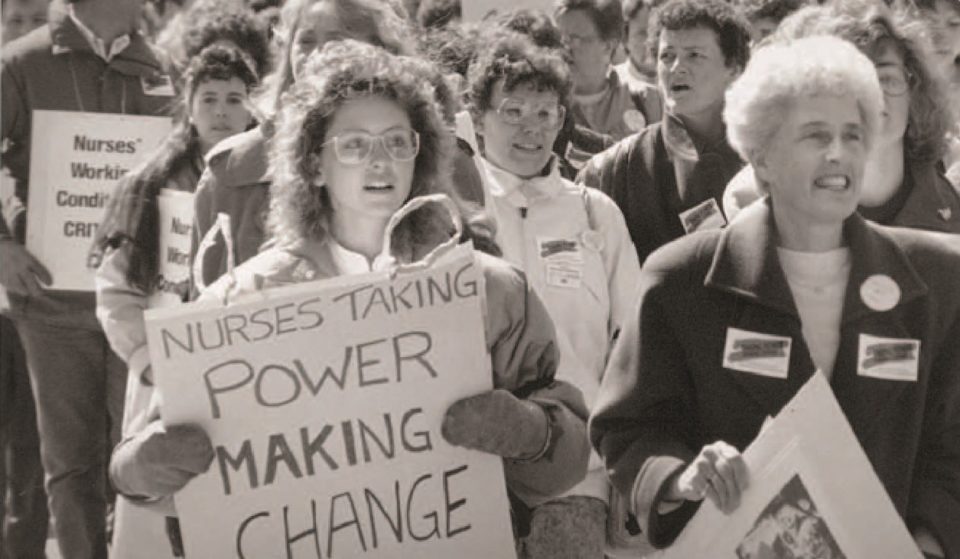
At a meeting of the Registered Nurses’ Association of Nova Scotia, held on June 14 and 15 in Stellarton, the membership formed the Nova Scotia Nurses’ Union. The association was dissolved, and a provincial union with chartered locals was formed. This was the result of the recognition that a new and stronger constitution was needed, and the increased recognition that the professional association and bargaining body needed to be separate. Tom Patterson, the former Labour Relations Officer, became the new Executive Director, with Winnie Kettleson serving as President.
On May 6, 1977, Alberta’s provincial nurses’ association called a general meeting to be held immediately after its annual meeting. 1,300 nurses attended this meeting in Calgary to discuss the creation of an independent bargaining organization. Gurtey Chinell, chairperson of the association’s bargaining committee, announced the decision to form an independent organization and requested the support of the association to protect existing collective agreements. The United Nurses of Alberta was born.
On June 14, 1977, the former bargaining committee moved into new premises as the United Nurses of Alberta, and the majority of staff nurses associations made applications for successor rights as chartered locals of UNA.
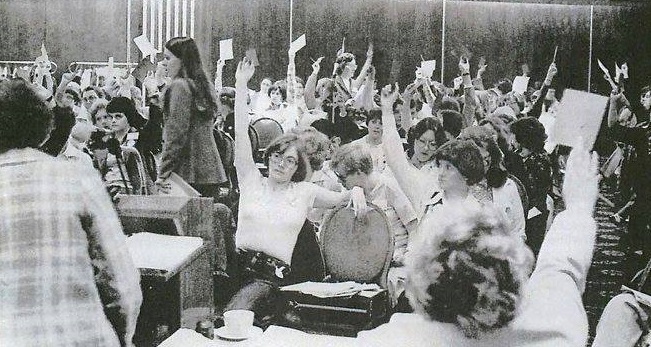
Led by the Saskatchewan Union of Nurses (SUN), the Newfoundland and Labrador Nurses’ Union (NLNU), and PEI’s Provincial Collective Bargaining Committee (PCBC) (the forerunner of the Prince Edward Island Nurses’ Union), a committee was formed to discuss the potential structure, funding and constitutional provisions that would be needed to create a national organization to represent the voice of unionized nurses. Discussions, which began in 1978, led to a founding convention in late April 1981.
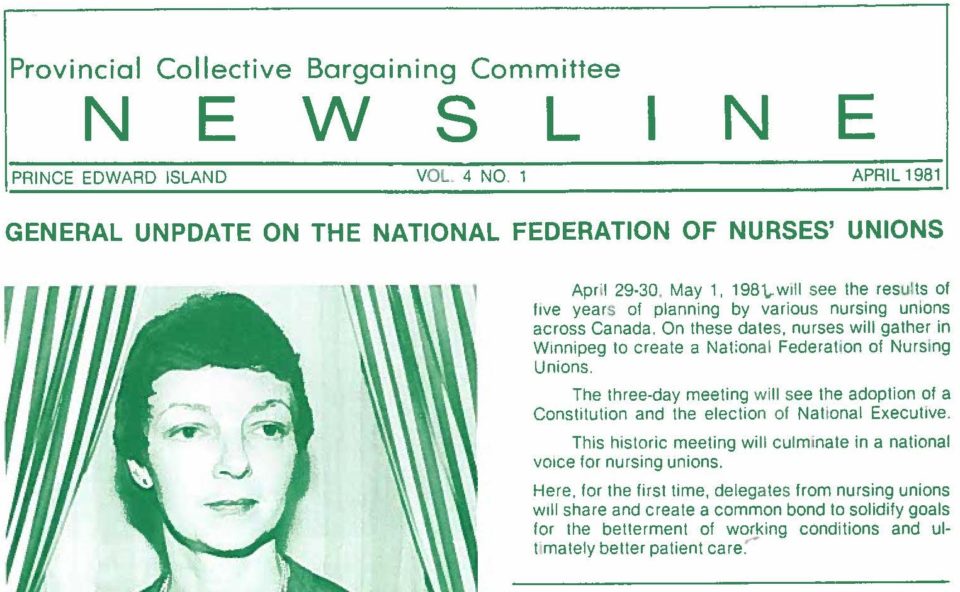
In 1978, five years after the landmark Supreme Court decision, the New Brunswick nurses formed an autonomous union, the New Brunswick Nurses Union. The fledging union was formed out of the previous provincial bargaining council, part of the provincial nurses association. Their ties to the association were gradually severed, and eventually the association divested itself of any involvement in collective bargaining for nurses.
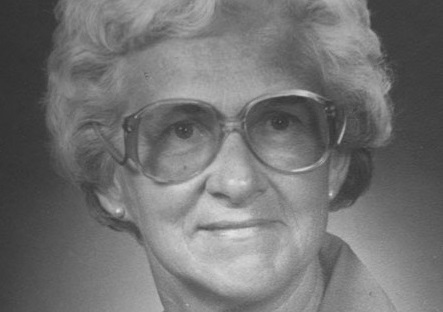
At SUN’s annual meeting in 1978, a key decision was made that recognized the importance of member education. Members recognized that more nurses needed to be educated in the fields of public and labour relations, bargaining and negotiations, not only to foster leadership at local and provincial levels but also to ensure union members were active and knowledgeable.
This led to the creation of SUN’s labour schools taught at the beginner, intermediate and advanced levels, and covering a wide range of topics.
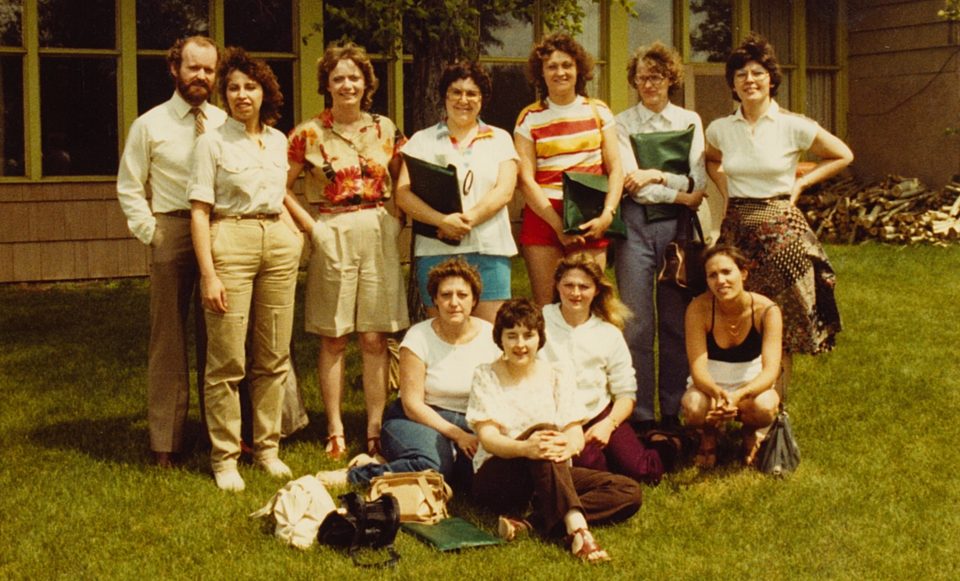
Following the formation of the United Nurses of Alberta (UNA) in 1977, an informal staff nurses association remained at the University of Alberta Hospital.
In early 1979, the legislation that set the terms and conditions of government bargaining with its employees, including those at the University Hospital, was amended. The change eliminated the restriction that nurses could only be certified as part of the Civil Service Association, making it possible for the approximately seven hundred University Hospital nurses to form their own bargaining unit. The Staff Nurses’ Association of Alberta (SNAA) was certified as a bargaining unit on August 21, 1979. The SNAA would go on to organize and represent nurses at about 15 different sites over the years in acute, community and long-term care.
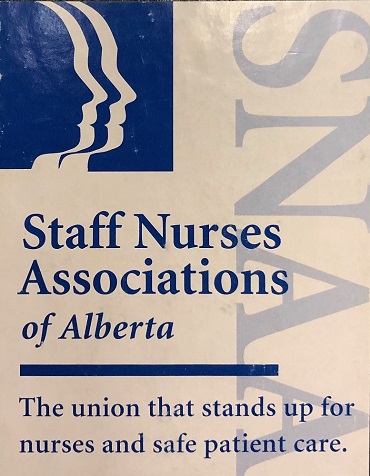
In the late 1970s, the CNA had drafted a Code of Ethics that implied nurses’ strikes were unethical because they placed self-interest, better wages, and improved working conditions before the needs of patients. At the 1980 CNA meeting in Vancouver this controversial ethics code disallowing strikes was defeated. Nurses unions across the country eventually won the right to strike after many long and arduous struggles.
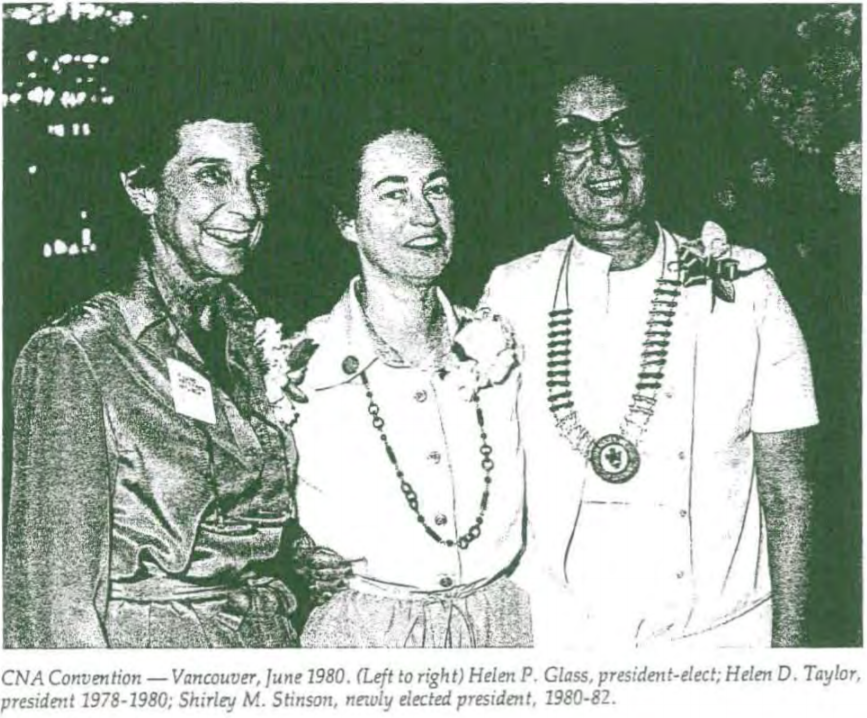
The first Eastern Labour School for nurses was held around 1980 at Mount St. Vincent University in Halifax. Quebec, Nova Scotia, PEI and Newfoundland & Labrador nurses participated in the school. Glenna S. Rowsell, the first employment relations officer for the New Brunswick Nurses Union, started the school with other Atlantic unions, and participated every year until her death in 1988.
The labour schools were significant because they brought nurses from different provinces together to learn, fostering leadership in the union movement.
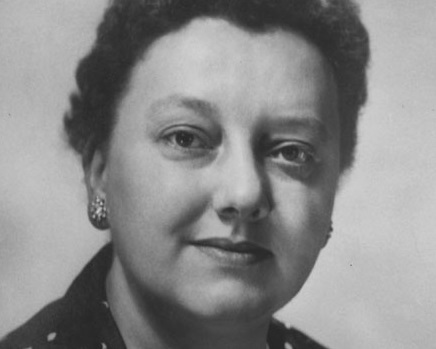
For years, nurses unions across the country had recognized the need for a national organization to advocate on their behalf. In 1981, these discussions led to a founding convention at the Fort Garry Hotel in Winnipeg, opened on April 29 by Sonny Arrojado, president of the host union from Manitoba.
On May 1, 1981, International Workers’ Day, the creation of a new national organization to represent unionized nurses across Canada was formally announced. More than 300 delegates representing every nurses union in Canada were present and voted unanimously in favour of creating the National Federation of Nurses Unions (NFNU).
Founding member organizations were the New Brunswick Nurses Union, Newfoundland and Labrador Nurses’ Union, Manitoba Organization of Nurses Associations, Prince Edward Island Provincial Collective Bargaining Committee and Saskatchewan Union of Nurses. Jane Murray of Prince Edward Island served as the convention chairperson, and Kathleen Connors of Manitoba served as secretary.
Sonny Arrojado was elected as NFNU’s first president, Mary Dwyer of Newfoundland as vice president, and Jill Jones of Saskatchewan as secretary-treasurer. The first meeting of the executive board took place in Ottawa on May 25 to 27, 1981.
Some of the NFNU’s first objectives included developing common bargaining goals, advocating for standardization of working conditions for nurses across the country and becoming a national voice to speak for nurses on major issues.
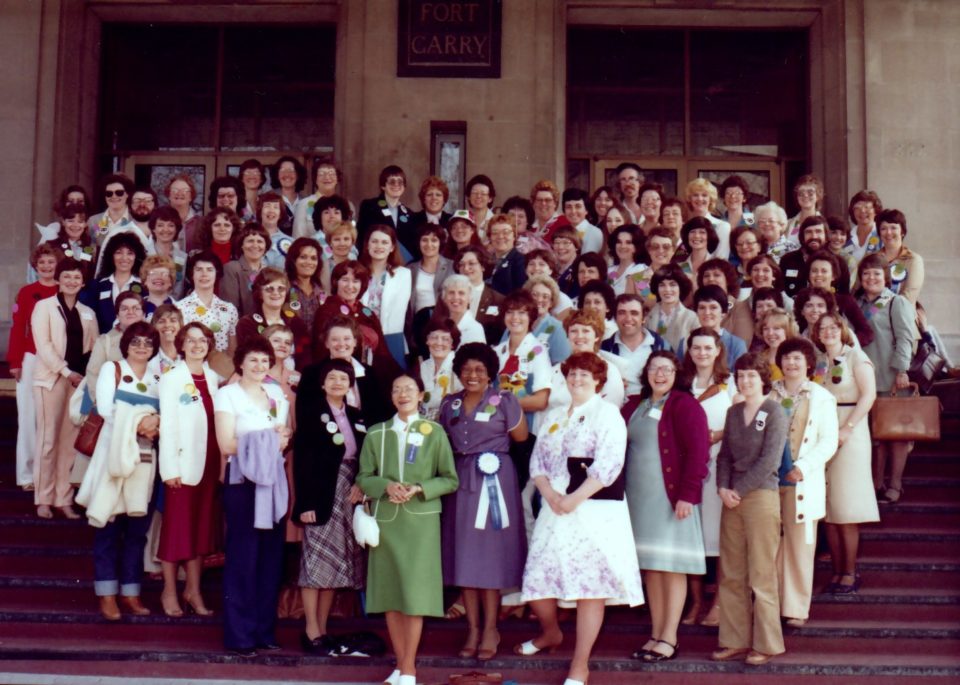
In 1976, following the landmark Supreme Court of Canada ruling, a labour relations division of British Columbia’s provincial nurses association had been created to act as the bargaining agent for nurses. In 1980, a committee was formed to study the issue of separation between the association and the labour relations division. The committee unanimously recommended the two bodies separate completely. In February 1981, a special founding convention was held. The vote to become the British Columbia Nurses Union (BCNU) was passed unanimously.
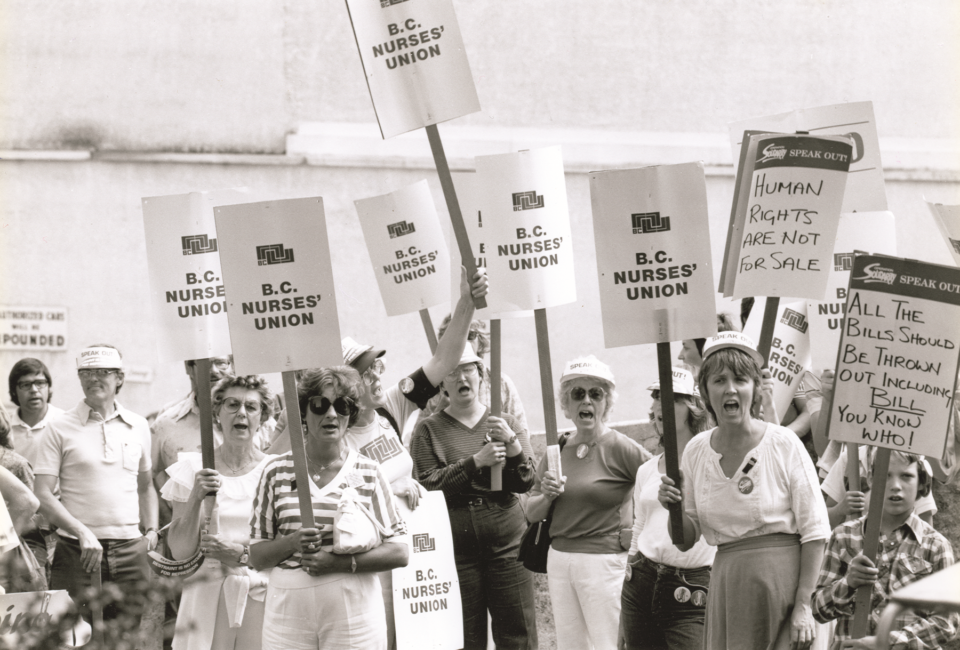
In the early years, most nurses unions were focused on negotiating contracts, handling grievances and other labour relations issues. However, broader issues relating to the health care system and social justice were important to nurses as well. These issues were often raised as resolutions at annual/biennial general meetings or at the governing body meetings.
At the NFNU’s 1982 special convention, Manitoba brought a resolution that the National Federation of Nurses Unions join the Canadian Health Coalition, and it passed. Championing Medicare and other social justice issues became a focus for the NFNU and its Member Organizations.
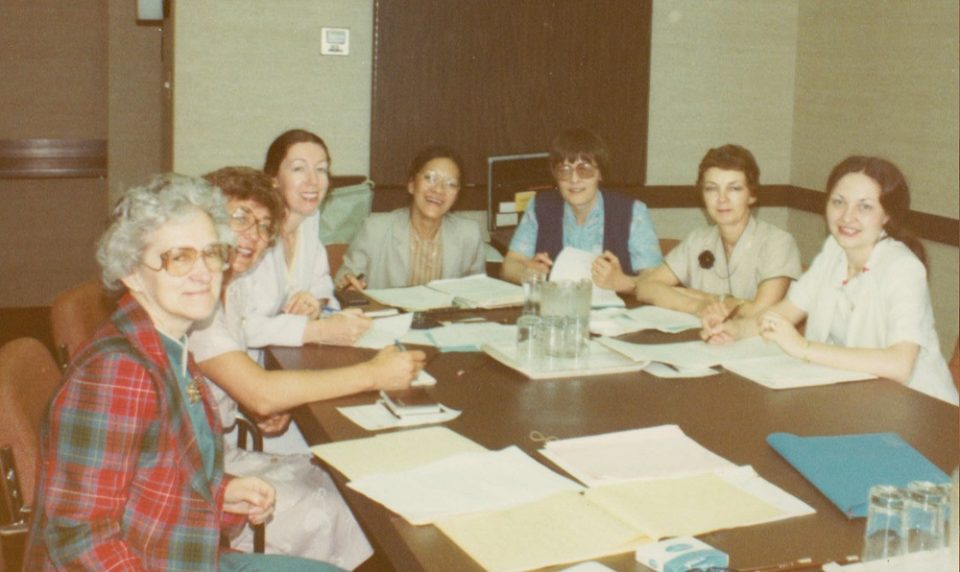
Building the NFNU to its current size and strength was no easy task. Everyone knew that it was important for unionized nurses to have a national voice and presence, but not everyone shared a common vision of what the NFNU was or should strive to become. A significant milestone was reached when NFNU established a full-time office in Ottawa in September of 1987 and the president became a full-time position.
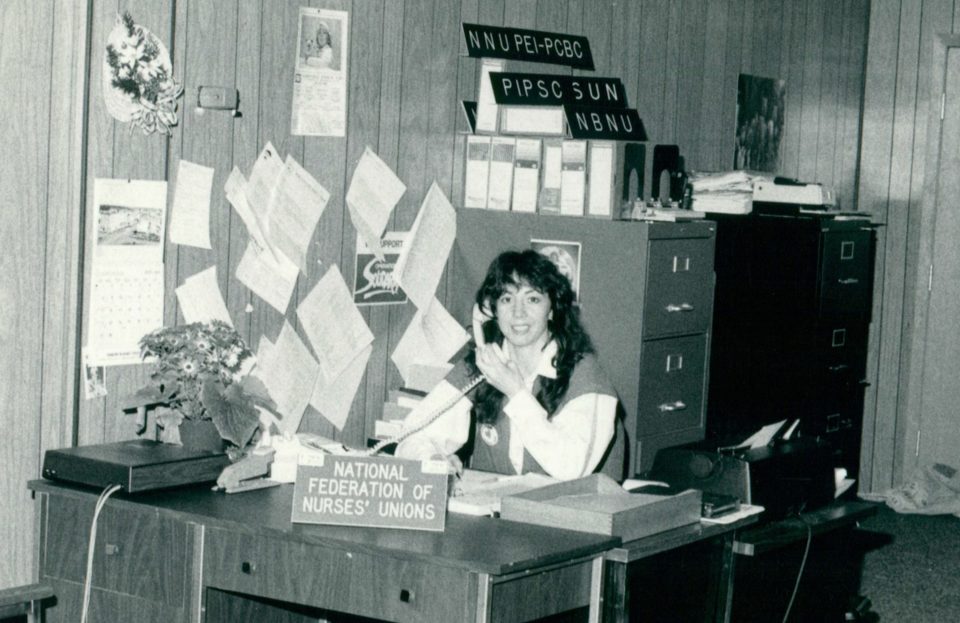
On September 7, 1987, after years of lobbying, the Labour Act of Prince Edward Island was amended to include nurses. With the amendment, bargaining rights were secured under the Act, and the PEI Nurses’ Union formally evolved from an organization structured as a committee of the provincial nurses association (Provincial Collective Bargaining Committee – PCBC) to a fully autonomous union and the recognized bargaining agent. This change would provide greater autonomy, certain advantages to nurses in the collective bargaining process and better services to its members. The constitution of the union was rewritten and a more democratic structure emerged. PEI was the last province in Canada to establish a nurses union.
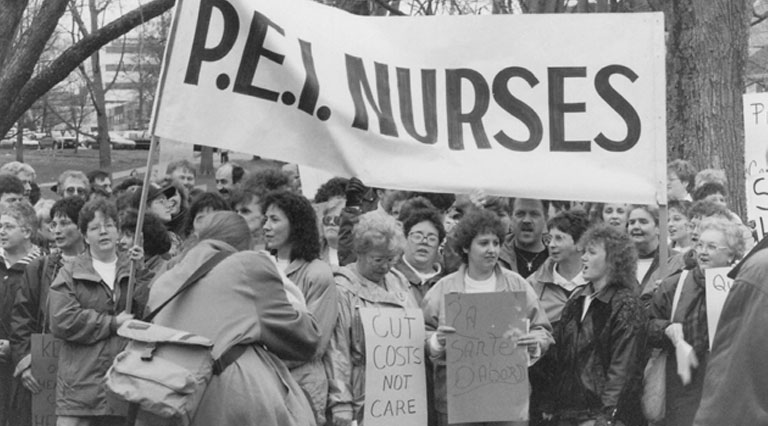
Born from the merger of three nurses organizations – Fédération des infirmières et infirmiers unis, Fédération québécoise des infirmières et infirmiers, Fédération des syndicats professionnels d’infirmières et d’infirmiers du Québec – the Fédération des infirmières et infirmiers du Québec (FIIQ) was officially founded on December 2, 1987. The FIIQ was renamed Fédération interprofessionnelle de la santé du Québec (FIQ) in 2006.

Faced with months of turbulent negotiations and greedy employers demanding rollbacks, on the morning of January 25, 1988, more than 14,000 nurses at hospitals across Alberta walked off the job, beginning a province-wide strike by UNA members – this despite the fact that the government had removed the legal right of hospital nurses to strike, following a previous job action.
The same day, the labour board presented UNA with a cease-and-desist order, and on February 4, a court found UNA guilty of criminal contempt of court, with a fine of $250,000 to be paid within five days. A second criminal contempt charge would result in another fine of $150,000.
Individual nurses faced, but were undeterred by, threats, termination notices, civil contempt of court charges and fines of up to $1,000.
Following late night negotiations, employers tabled an improved offer on February 11. The next day, UNA members voted to accept the employers’ latest improved offer, and a settlement was reached.
Nurses returned to work February 13, 1988, with a negotiated collective agreement. With the help of donations from other unions and individuals, UNA paid approximately $426,750 in fines.
The 1988 strike set the stage for UNA to make significant gains for nurses in the 1990 contract negotiations. This strike helped define UNA members as a force that would not hesitate to take a stand for positive change in our health care system.
Following a seven-day strike by nurses in Quebec in 1989, the Bourassa government imposed a draconian law that suspended the collection of union dues and stripped one year of seniority for every day a nurse was on strike.
Nurses responded to these measures in a spirit of solidarity. They agreed to respect true seniority. By remaining united, nurses showed the government that their attempt at dividing them would fail. During this time period, with the government aiming to eliminate the union, their slogan became “Being here tomorrow.”
That spirit of solidarity among nurses also led union members, along with colleagues from provincial nurses unions from across the country, to contribute financially in order to share the costs of the millions of dollars in fines imposed by the government after both the 1989 strike and a later strike in 1999.

In May 1989, BC nurses voted overwhelmingly in favour of job action. By mid-June, 69 facilities were behind picket lines. On June 26, a tentative settlement was reached and recommended by both the employer and BCNU’s bargaining team.
A large and vocal group of nurses were extremely unhappy with the deal and the lack of bargaining information coming from the union office. A Vote No campaign was organized and, on July 12, 65% of nurses voted against ratification, with members in eight of BCNU’s nine regions rejecting the deal.
In August a mediator stepped in and, on August 18, announced a series of binding recommendations. The new contract was for two years instead of three and raised wages by 20.9%, to be the highest in Canada. The BCNU accepted the terms under duress.
The bitter six-month struggle resulted in important lessons that shaped the union going forward. The BCNU moved to become more a member-driven, grassroots organization. The importance of communicating effectively back and forth during job action was another important takeaway.
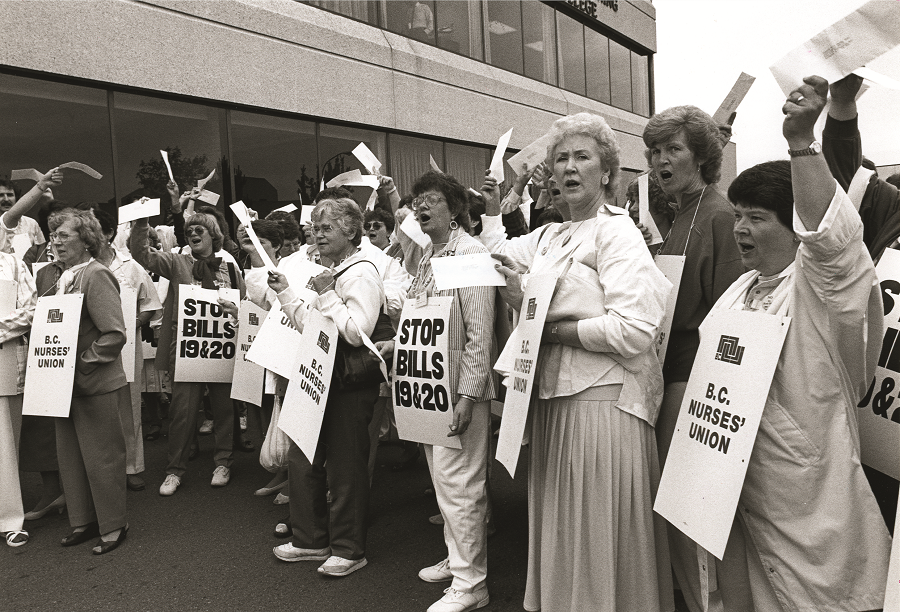
After two failed attempts, Manitoba nurses agreed to accept the word “union” in their name. The name change passed by a vote of 141/58. Some nurses were concerned that the public might be less sympathetic if they used the word ‘union’ but then-president Vera Chernecki said to the Winnipeg Free Press: “We want people to take pride in the union, especially at a time when nurses are demanding more respect when dealing with employers and governments.”
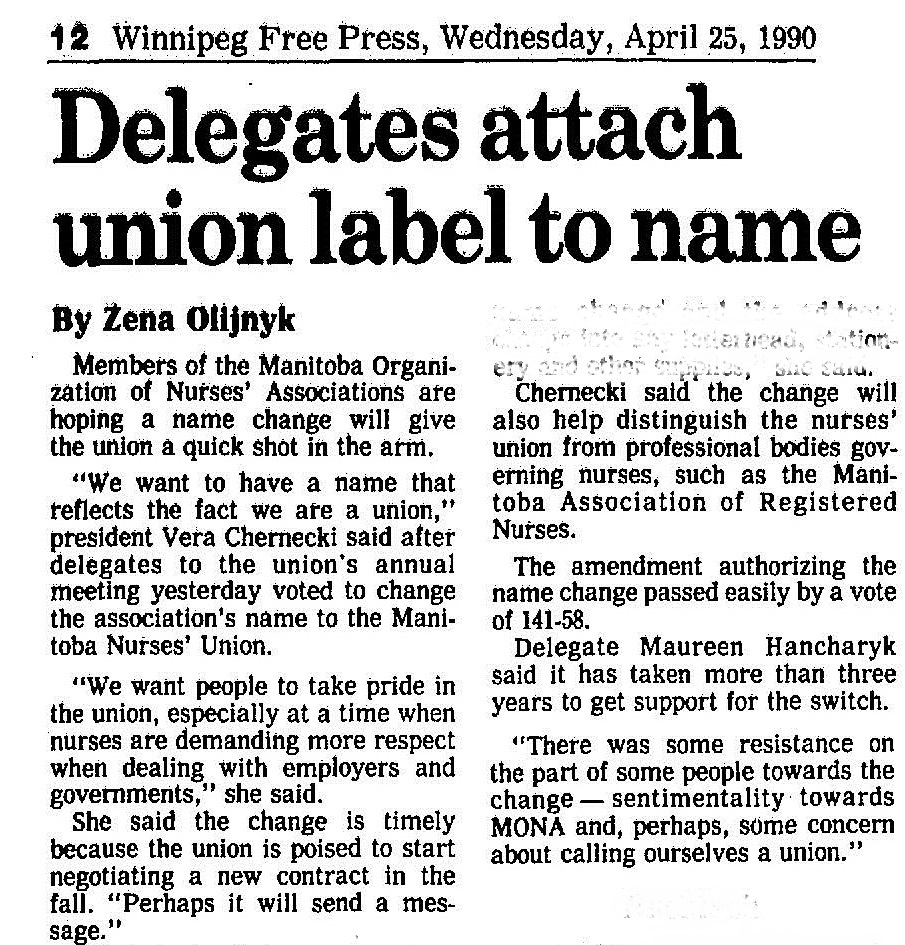
The January 1, 1991 strike of 10,000 Manitoba nurses was the longest and largest in the province’s history. It was also the largest single job action in the province’s history since the Winnipeg general strike of 1919.
Despite temperatures that dipped below -37 centigrade, nurses were resolute in pushing back against the anti-nurse policies of the Conservative government of Gary Filmon. Through the strike, and standing up for patient care and a fair collective agreement, Manitoba nurses won the respect and recognition of people across Canada.
The year after the strong showing in the 1991 strike, a newly elected government hired a Chicago-based consulting firm to consult on cutting health care costs, and the provincial government attempted to eliminate LPNs (licensed practical nurses) from the hospital units and replace them with nurse aides. The MNU launched an aggressive ad campaign and “ran the consultant out of town,” according to then-president Vera Chernecki.
Nearly 20 years after the formation of a national organization to represent university student nurses, the idea of including diploma student nurses was revived at the 1988 CNA convention. Almost four years of deliberation at national assemblies of the CUNSA ensued before, on February 1, 1992, at the CUNSA national conference hosted by Queen’s University in Kingston, Ontario, diploma students were recognized as regular members. The name of the association was changed to become the “Canadian Nursing Students’ Association” (CNSA).
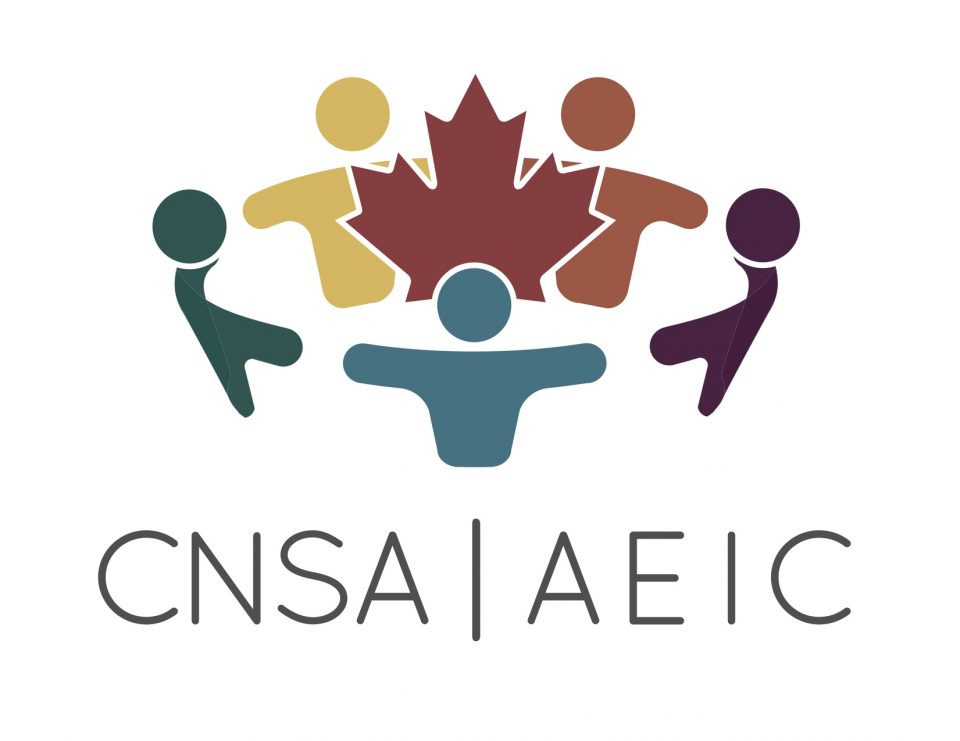
In time, the effort and work to build the NFNU started to reap returns. Under Debra McPherson’s leadership, the British Columbia Nurses’ Union (BCNU) became a member of the NFNU in 1992. Externally, the NFNU was being recognized as a strong, realistic and reliable voice speaking and working on behalf of nurses. Governments and employers, non-governmental organizations and other unions acknowledged the growing credibility of the NFNU and its membership.
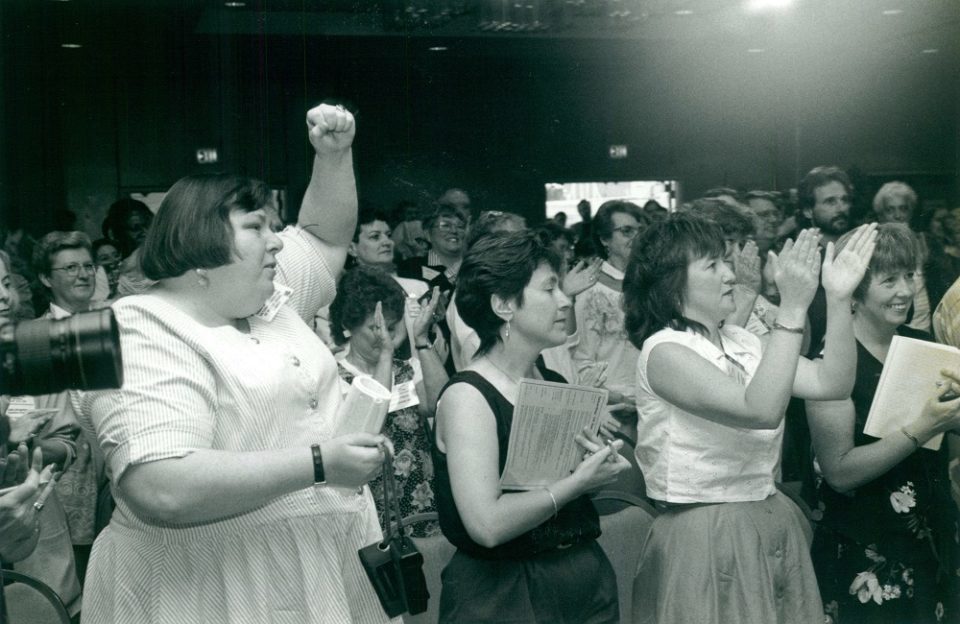
In 1991 the NBNU launched a public awareness campaign to protest a government bill that violated the Public Service Labour Relations Act by freezing wages for one year. This was compounded in 1992 when the government passed legislation that would again freeze wages and extend collective agreements for three years for all public sector unions.
The NBNU released a statement on May 29, 1992, warning the government that nurses had voted to strike to defend their rights under the collective agreement, which they had signed in good faith. The strike date was set for Monday June 4, which got premier Frank McKenna’s attention. After intense bargaining between the NBNU, led by president Linda Silas, and the government of N.B., led by the premier himself, nurses reached a deal. The deal protected nurses’ negotiated wages and prevented the strike that had been scheduled for two days later. Sadly, members of CUPE weren’t as successful and went on strike for two weeks before reaching a deal with government.
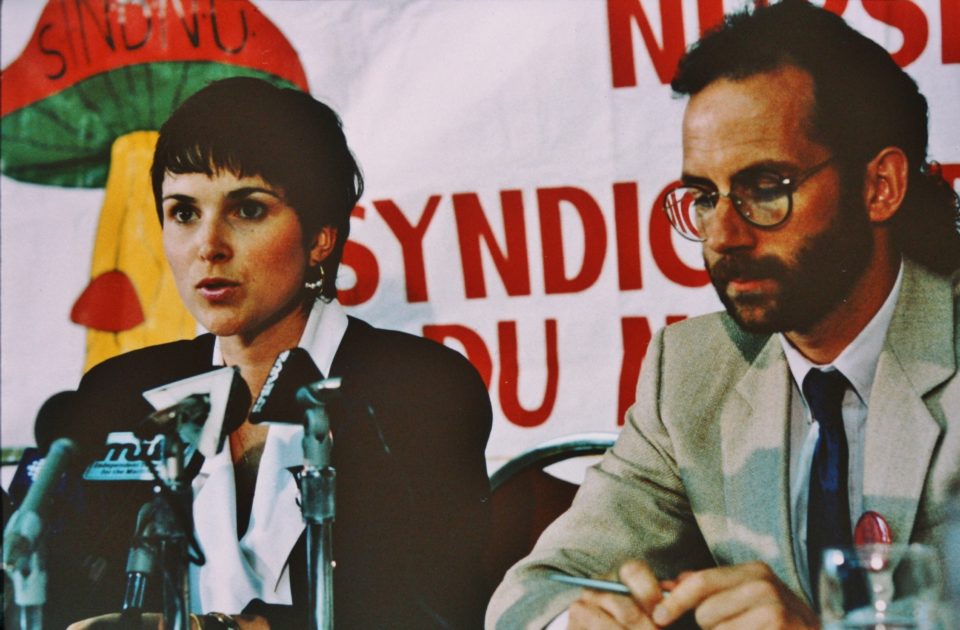
1994 was a year of disillusionment and upheaval for the PEINU. A bill was introduced and became law which slashed public sector wages by 7.5% for those earning more than $28,000 annually. The PEINU was the only union to have all of its members hit with the reduction. The six affected unions formed a coalition and worked together to protest the move.
The coalition organized several rallies at the provincial legislature, held a protest outside a Liberal Party fundraiser charging $1,000/plate, conducted polls, media campaigns and local outreach. The message was that such a reduction would hurt everyone. Collective action and mutual support was integral to pushing back against the regressive changes.
The Public Sector Pay Reduction Act legislation expired on May 16, 1995.
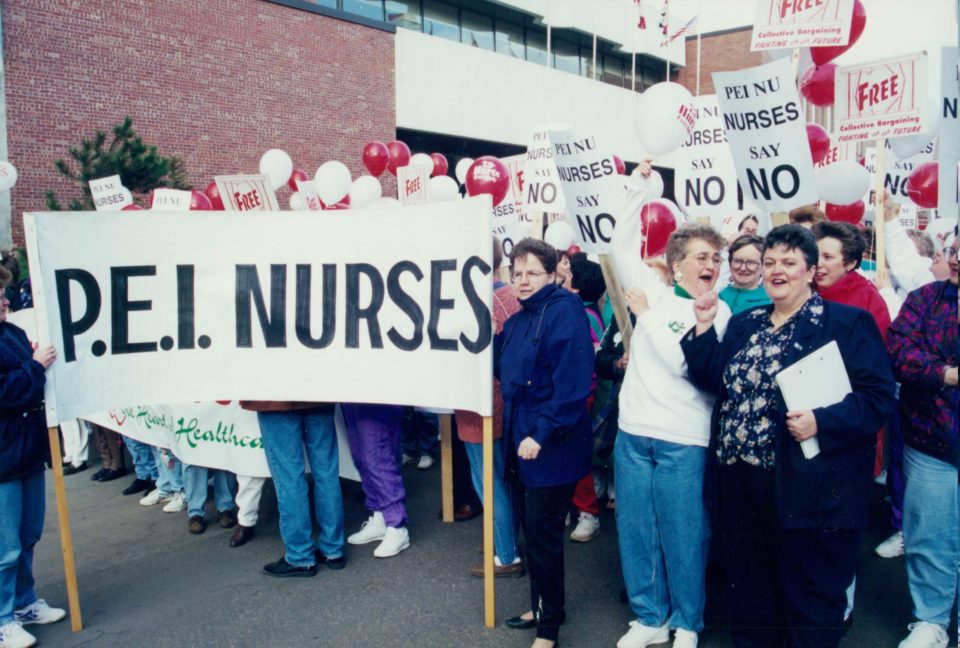
UNA was a trailblazer among nurses unions in information technology, and ahead of many employers. Starting with a small network in 1992, UNA set about connecting its two offices, executive board, and locals to the UNA network, providing training and support to do so. UNA staff person Florence Ross recalls driving all over the province in those early years, delivering computer equipment, and providing training aimed at empowering local leaders to master the basics of computer use.
In 1995 UNA became the first Canadian nurses union to have a website. Ross recalls writing all the code for that first website herself.
By 1996 all of the UNA locals were on computers and belonged to the UNA network. This single fact meant huge improvements in the quality, quantity, frequency and timeliness of internal communication.

Previous attempts to join Alberta’s two nurses unions together had failed, but in 1997, faced with a provincial government that wanted to negotiate with only one nurses union, the Staff Nurses’ Association of Alberta and United Nurses of Alberta agreed to meet to re-open discussions regarding amalgamation.
The unions found common ground, and an amalgamation agreement was achieved and approved by both executive boards. This agreement set the date of October 15, 1997, as the legal date of amalgamation. SNAA president Pauline Worsfold would become a UNA executive officer for one year, responsible for transition issues.
In late September, the SNAA and UNA membership voted overwhelmingly in favour of the amalgamation. This merger increased the strength of nurses in Alberta. With one voice, nurses could now more effectively advocate on a range of issues affecting the lives of patients, clients, residents, nurses and all Albertans.

As nurses worked to build their own national body, the need to work more closely and formally with other labour organizations was being embraced. SUN was the first nurses union to affiliate to a provincial federation of labour in 1996. SUN subsequently approved joining the Canadian Labour Congress (CLC) in 1997. BCNU and MNU also voted to join the CLC in 1998.
Affiliation to the CLC by three nurses groups would make it necessary for nurses to join the CLC through a national body. The NFNU board members agreed that the next logical step would be for the NFNU and all its Member Organizations to affiliate to the CLC. The constitutional changes to make this a reality happened at the June 1997 NFNU Convention in Vancouver.
In January 1998, the NFNU became a member of the CLC, one of the eight largest affiliates and one of the four largest public sector union affiliates. This reality gave the NFNU a seat on the executive committee of the CLC, and the NFNU immediately assumed a leadership role within the CLC. NFNU delegates attended their first CLC convention in May 1999. Affiliation to the CLC provided support for collective bargaining in areas such as occupational health and safety, pensions and benefits.

At the 1999 NFNU convention in Fredericton, New Brunswick, delegates voted to change the name of the NFNU to the Canadian Federation of Nurses Unions (CFNU). The organization had just joined the Canadian Labour Congress and was beginning to do work on an international stage. Member Organizations wanted a new name for their national organization that would include the word ‘Canada’, reflecting the new global context of its advocacy work and focus.
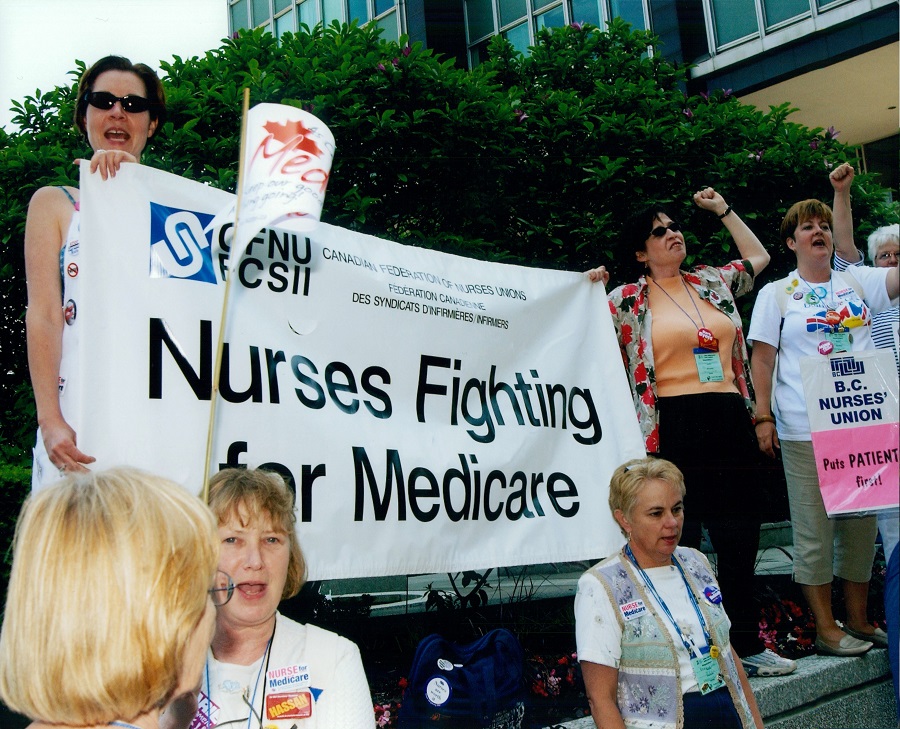
In 1999, Newfoundland and Labrador nurses were in contract negotiations. The province was emerging from a period of wage freezes, and other unions had accepted a 7% wage increase over 39 months. Local NLNU presidents believed members would accept the same package, but member research said they would not be satisfied with this increase. When members voted on the contract, it was defeated by a small number of votes, followed by strong support for a strike.
The strike started on March 24 and ended nine days later with return-to-work legislation. Following this, nurses launched a work-to-rule campaign which led to the government launching a classification review and offering higher increases and other benefits.
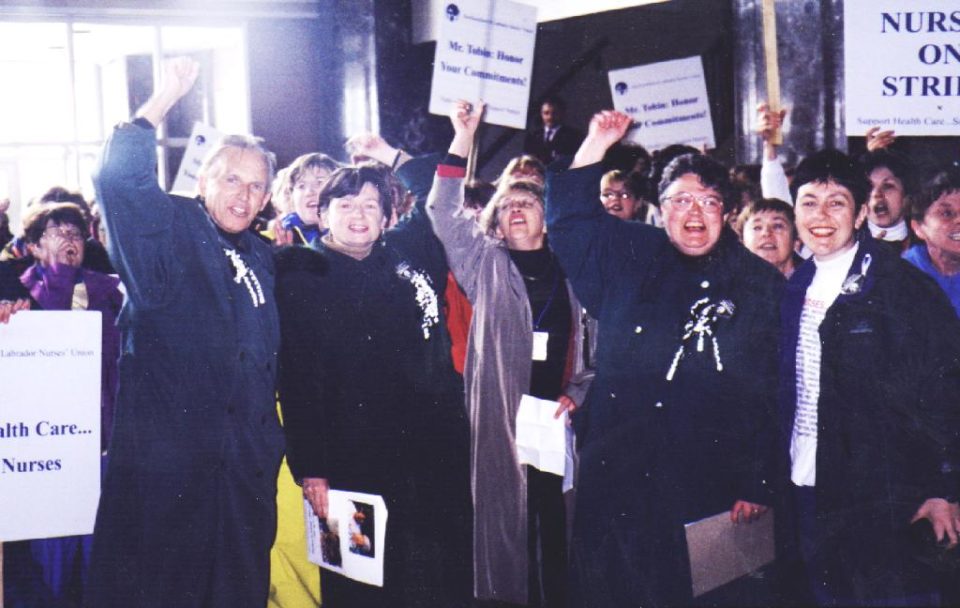
By the end of 1998, Roy Romanow’s provincial government admitted there was a chronic shortage of nurses in Saskatchewan. SUN was fighting to keep nurses in the profession to maintain adequate staffing levels and a consistent quality of patient care. Nurses were leaving the profession because they were overworked, underpaid and undervalued. SUN argued if these issues were not addressed in the 1999 contract, there would be fewer nurses than ever, and levels of patient care would suffer accordingly.
In December 1998, SUN members voted in favour of strike action. This was the first time in SUN’s history that a strike vote had taken place before negotiations even began.
The day nurses walked out, the government passed back-to-work legislation and imposed settlement terms. Nurses defied the legislation. Nurses faced fines for the illegal strike, but after 10 days on strike the government and union signed a memorandum of understanding to get back to the bargaining table and, in the end, a large settlement was negotiated.
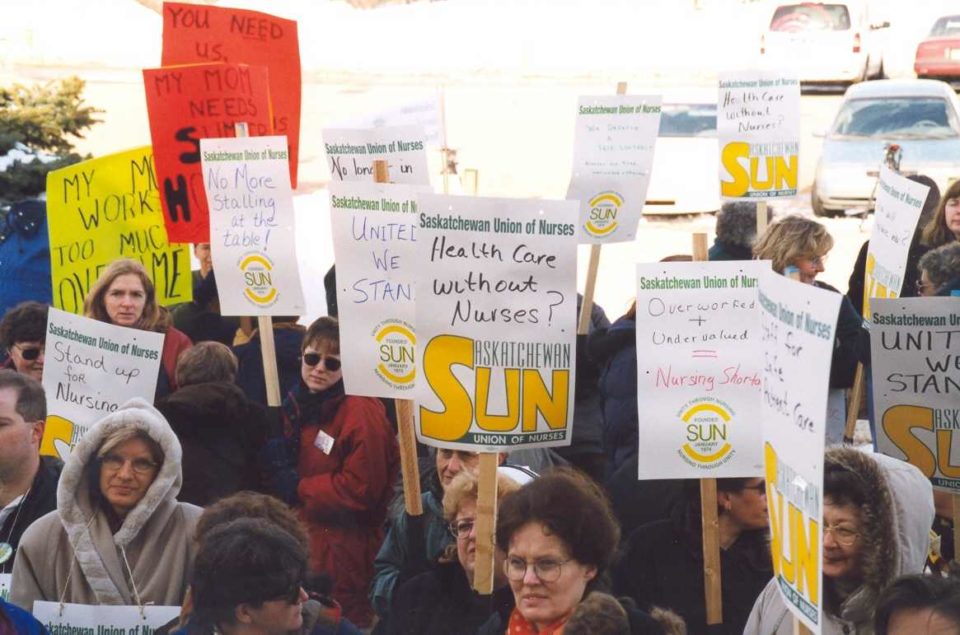
By the year 2000, SUN, NSNU and PEINU had all voted to re-join the CFNU after periods of disaffiliation. United Nurses of Alberta (UNA) joined in 1999, two years after merging with the Staff Nurses’ Association of Alberta. In November of 2000, the Ontario Nurses’ Association (ONA) voted overwhelmingly to join the CFNU. The ONA decision meant that all provincial unions, with the exception of the Fédération des Infirmiers et Infirmières du Québec (FIIQ), had chosen to add their voices, energy and strength to the CFNU.
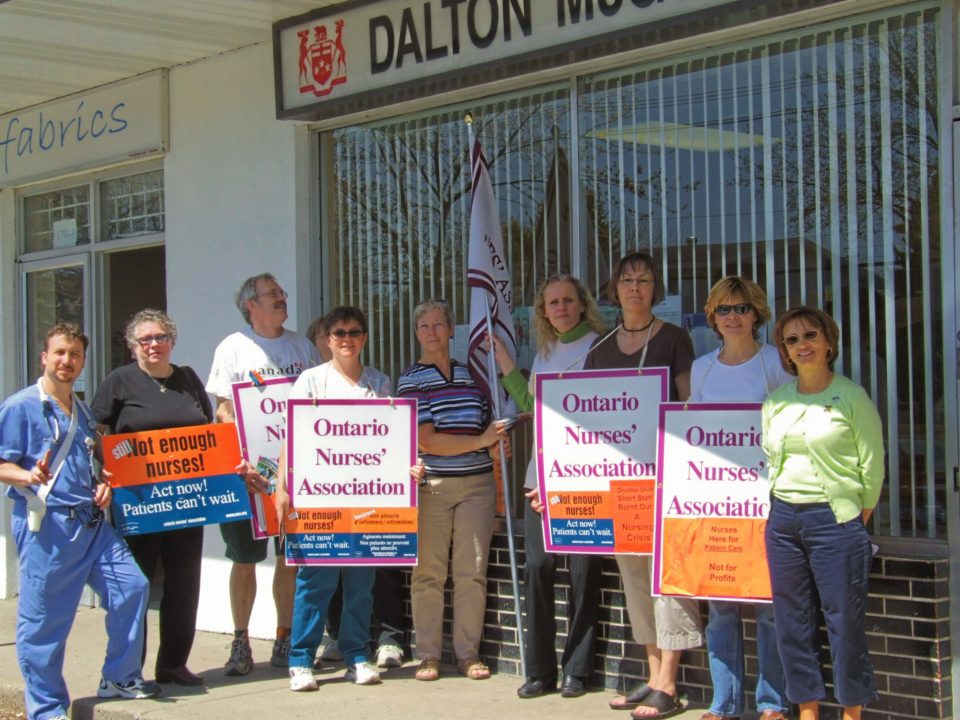
When SARS hit Ontario in 2003, it hit a severely depleted and demoralized health care system, following years government cutbacks. Nurses were on the front lines, and two nurses died during the second wave of SARS in Toronto. Nurses had warned that SARS wasn’t over, but were told to take off their masks and isolation protection. Linda Haslam-Stroud’s first press conference as ONA president was held to announce a lawsuit against the government. ONA lost that lawsuit, but the province learned that it couldn’t push nurses around. Continued advocacy with allies resulted in a government regulation requiring health care facilities to use safety engineered devices, and respirators were stockpiled to protect health care workers in the event of another outbreak.
In 2007 a new category of membership in the CFNU was created to enable the Canadian Nursing Students’ Association (CNSA) to become member. Associate membership allows the CNSA to have representation through the CFNU and on its national executive. The CFNU was the first national nurses organization to do this.
This move was made in recognition of the need to provide mentorship to new generations of nurse leaders, and out of a desire to provide meaningful representation for nursing students while at school and as they enter the workforce.
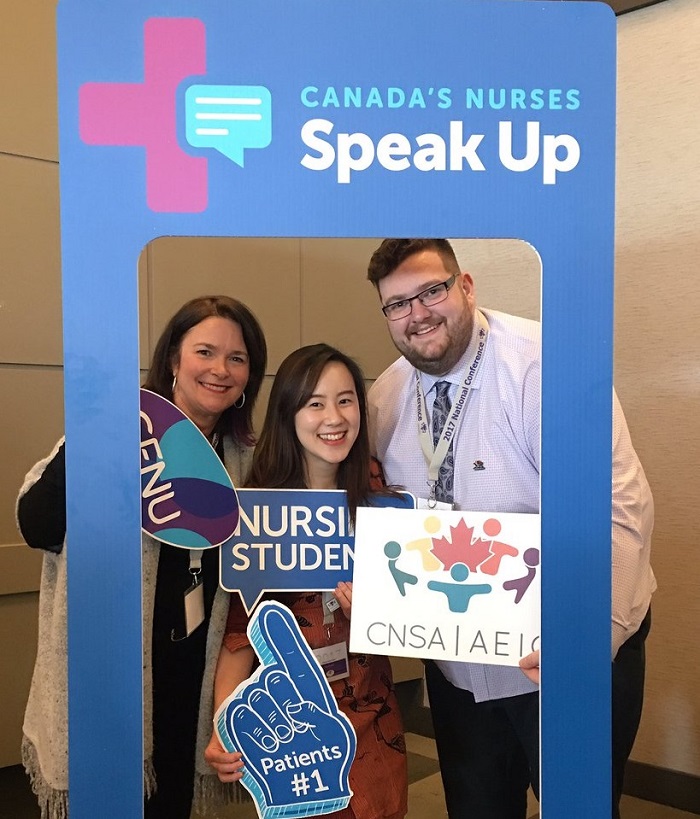
Contract negotiations saw the union squaring off against Premier Danny Williams, whose government ran advertisements ridiculing the union’s demands. The union secured a strike mandate and was just two hours away from job action when a historic agreement was reached with the provincial government. President Debbie Forward had crafted a solution that was accepted after a long night of back-and-forth discussions. This proved the power that a strike mandate and a strike deadline can have for achieving membership priorities and moving government.
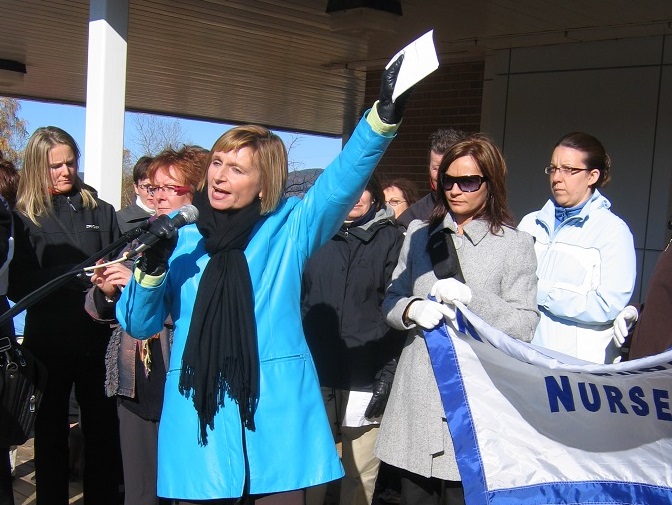
The BCNU ran a campaign in 2009 to attract licenced practical nurses (LPNs) to their union. LPNs in BC were represented by the provincial Hospital Employees’ Union, and BCNU’s action was deemed to be raiding by the Canadian Labour Congress (CLC). Raiding members of another union is a violation of the CLC constitution, which seeks to protect unions from having their members lured away by another union.
By 2011 the BCNU had been suspended from the BC Federation of Labour and the CLC for raiding. The CFNU had worked at different levels to encourage the BCNU to comply with both the CFNU and CLC constitutions but, in the fall of 2011, the BCNU agreed to remove itself from the CFNU.
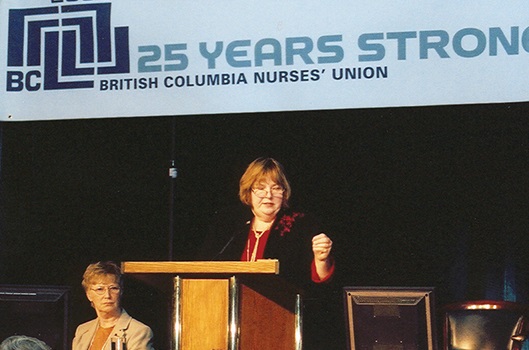
In 2011, the NSNU, under the leadership of president Janet Hazelton, proposed mandatory uniforms for RNs, LPNs and NPs. The uniform of white tops and black bottoms aimed to make nurses more visible to the public, which hadn’t been particularly sympathetic to concerns about nursing shortages due to lack of awareness as it was hard to distinguish nurses from other hospital employees. The move was initially controversial among members but ultimately successful at helping to create visibility for nurses in their workplaces.

In 2013, leaders of major nurse and health care worker unions from 14 nations in the Americas, Africa, Asia, and Europe announced plans to form a new international organization to step up the fight against the harmful effects of austerity measures, privatization and cuts in health care services that put people and communities at risk across the planet.
Calling the new organization Global Nurses United, leaders of the initial founding organizations – including the CFNU – said they would work collectively to guarantee the highest standards of universal health care as a human right for all, to secure safe patient care, especially with respect to safe nurse-to-patient ratios and safe health care workplaces.
As the participants said in their opening declaration: “We, the leaders of international nurses and health care unions, affirm our intention to work collectively to protect our professions, our patients, our communities, our work, our health, our environment and our planet.”
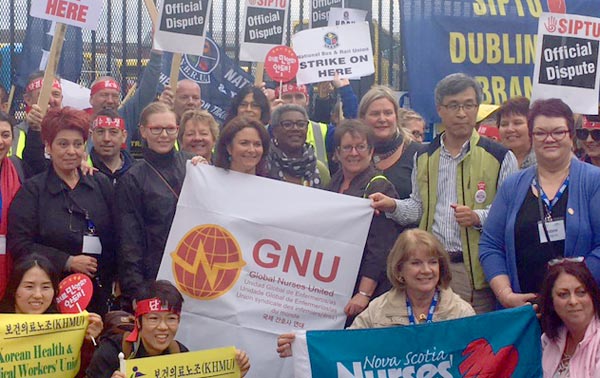
On October 16, 2018, 58 public health nurses from Thunder Bay, Ontario, were forced out on strike. While during their five weeks on the picket line the days were often long, cold and frustrating, the nurses found many creative ways to keep up the pressure on the employer. Morale was bolstered by messages of support from ONA locals, members, staff, other unions in Ontario, across Canada and in the United States. A settlement was finally reached on November 16.
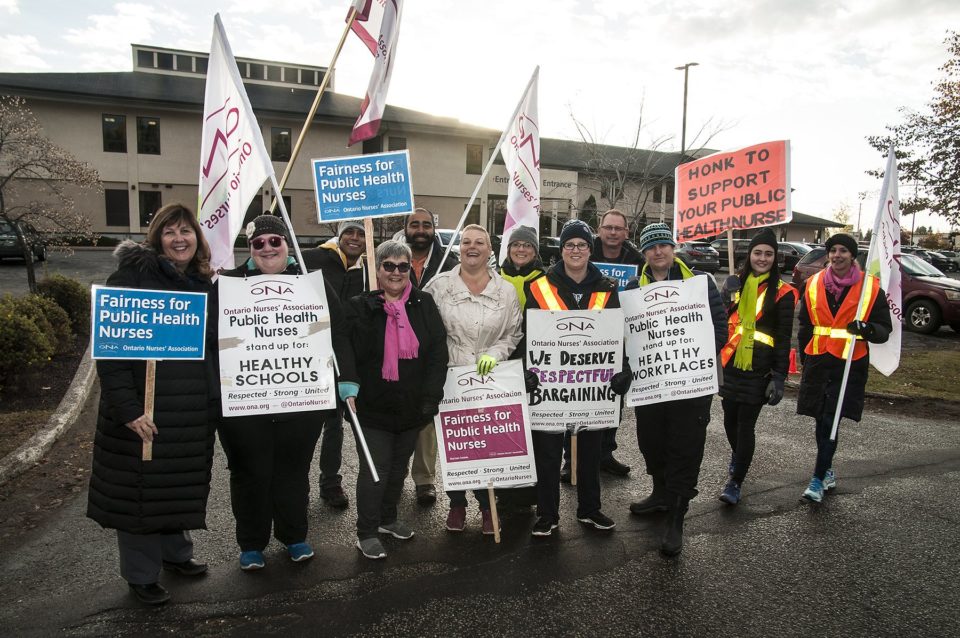
By 2019, under the strong leadership of CFNU President Linda Silas, all CFNU Member Organizations had affiliated with their provincial federations of labour.
In 2018, PEINU and RNUNL joined the PEI Federation of Labour and the Newfoundland and Labrador Federation of Labour, respectively. This left only one member organization – the Manitoba Nurses Union (MNU) – outside of their provincial house of labour.
On International Workers’ Day, May 1, 2019, the MNU voted to join the Manitoba Federation of Labour. This fulfilled the requirement for congruency of membership between provincial and national labour federations. Congruency of membership allows for a more united voice, and more coordinated action, to advance the interests of working people at every level.
